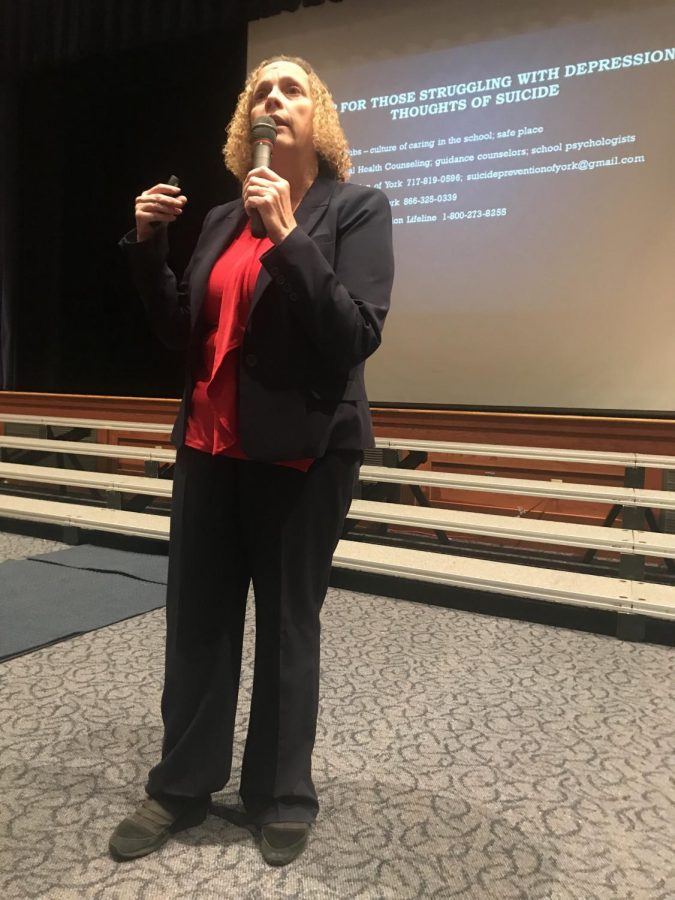County Coroner Talks to Student Body
Discusses risks of opioid addiction and death in York County
On October 27, the York county coroner and some of her colleagues visited the school and delivered a presentation on drugs, specifically heroin overdoses and how they affect people.
Parent Charlene Sciarretta, (one of the individuals brought in with the coroner), opened the presentation with a narrative about the heroin overdose of her son, Danny Sciarretta.
She also spoke of the ensuing court case that ended with Danny’s “friend” serving a prison sentence of two and a half to five years. The point of this was to show that even though an individual may not be partaking in the drug use, they are still implicated for allowing its use in his or her presence.
One of the main takeaways that Sciarretta gave is that “Heroin knows no boundaries.” She went on to explain how heroin doesn’t have a certain group of people that it affects, it goes wherever it is allowed and kills.
Sciarretta then spoke about how heroin can kill even if the user becomes clean. She explained that heroin affects the organs when it is used, often causing permanent organ damage that could later result in complications and death–even once the individual is clean.
She closed her narrative by stating that: “My hope is that someone here today will remember this, and never leave someone behind.”
After Sciaretta finished speaking, the Chief Deputy Coroner Claude Stabley, began presenting on the dangers, effects, and history of Heroin.
According to his presentation, Bayer brought heroin to the United States in 1898 by creating it as a morphine substitute and a strong pain reliever. The United States than outlawed the importation of opioids in 1909, while also banning its use.
Heroin is specifically dangerous because it slows down an individual’s breathing, which can cause individuals to go into a comatose-like state, or even stop breathing completely, which is what happens when a person overdoses.
Users of heroin can ingest it in three ways; snort it, inject it, or smoke it. Injecting it is the fastest way to get a high and the most common of the three forms of use.
Chronic use of heroin can cause skin abscesses and organ damage. On top of this is the fact that users that inject subject themselves to an extreme risk of disease, such as: Hepatitis C and Human Immunodeficiency Virus (HIV).
Risk of overdose for heroin users is high since the drug trade is illegal and completely unmonitored. This results in dealers adding dangerous substances to heroin, such as rat poison.
Next to speak was the county coroner Pam Gay. She went over some statistics regarding deaths from heroin and drugs in York County.
In York county, over the past four years, there have been 300 deaths due to heroin overdoses. In addition, 19 people under the age of 25 have died this year alone (so far), and there have been 80 confirmed heroin deaths.
Gay went on to discuss signs of heroin usage, which include flu-like symptoms, frequent breaks from work, pinpoint pupils, and skin lesions.
She concluded the presentation by explaining her support of Nalaxone (Narcan) and how it’s used. According to Gay, if someone overdoses, Narcan can be administered in order to reverse the overdose. Narcan should be administered as fast as possible to avoid damage to the brain from lack of oxygen.
If an individual wants to quit heroin, it can take anywhere from 12 to 24 months in order for an individual to be completely clean.
At the end of the assembly, Principal Heather Venne spoke to the student body telling them that the school supports mental health and understands the struggles of addiction. She made the students aware that there is a Narcotics Anonymous group that anyone can join, whether they are struggling with addiction or they know someone who is.
She also made the students aware of the the Mason-Dixon Area Anti-Drug Task Force that meets every second Tuesday of the month in the media center at 6:30. This task force meets and presents information about addiction, and also includes briefings from the state police and other officials.












